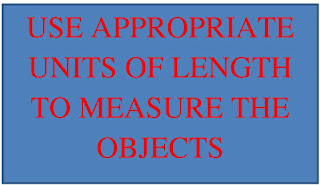LESSON PLAN OF USE APPROPRIATE UNITS OF LENGTH TO MEASURE THE OBJECTS
LESSON PLANNING OF USE APPROPRIATE UNITS
OF LENGTH TO MEASURE THE OBJECTS
Subject Mathematics
Grade 2nd
Students` Learning Outcomes
- Use appropriate units of length to measure (with straightedge / ruler) the objects.
- Solve real life problems involving measurements.
Information for Teachers
- In the past, people used different organs of their body (foot, arm, hand, finger etc.) to measure length of any object.
- With the passage of time changes occurred and different instruments (inch tape, meter rod, guzz etc.) and units (inch, foot, guzz etc.) were introduced at different places for length measurement.
- At time passed, man-made new standards of measurement i.e. made standard units and instruments, in order to establish standard system for the measurement everywhere.
- While teaching the lesson, the teacher should also consult textbook at all steps where and when applicable.
Material / Resources
Writing board, chalk / marker, duster, meter
rod, ruler with centimeter marks, measuring tape, rope pieces, and straws,
textbook
Introduction
- Ask following questions from students;
- Show them a meter rod and ask what this is?
- For what purpose it is used?
- What type of objects we measure by using meter rod?
- What is the small unit of length?
- Which symbol is used to represent meter?( m)
Activity
- Hold two threads in your both hands and show to students.
- Ask the students, if the length of one rope is 2 m and other rope is also 2 m then what will be total length of both ropes?
- If they can`t reply then keep both ropes in a line and measure total length by meter rod in front of them.
- Similarly ask them, if the length of this rope is 2 m and I cut 1 m length then how much length left?
- Demonstrate in front of them.
Development
Activity 1
- Divide the class in 6 groups and provide them meter rods and centimeter rulers.
- Ask the groups to measure the following objects.
Group 1: One side of table.
Group 2: Door
Group 3: Heights of each other.
Group 4: Arms of each other.
Group 5: Chalks of different sizes.
Group 6: Leaves of different sizes
- Ask all groups to write measurement / length on their notebooks using appropriate.
Activity 2
- Call one student in front of class and give him a straw.
- Ask him to measure the length of the straw and write on board e.g. 14 cm.
- Then give him another straw and ask him to measure and write length on board e.g. 14 cm.
- Then ask from students: can we measure these two straws together? How?
- Ask the students to measure the total length by placing them in a line.
- Write the answer in any corner of board. (28 cm)
- Tell the students that we can find total length by adding these lengths.
- Add both lengths by placing these lengths in vertical form with units and tell them the answer is same as they find by measurement
- Repeat above steps for subtraction. For this, cut some part of straw and ask students to see how much is left?
Activity 3
- Call two students.
- Give one rope to each and ask them to measure.
- Now write the word problem by using names and measurements of both students.
- For example;
- Solve this question with the help of students and tell them we place value below value and unit below unit and write a addition symbol with them.
- Repeat this activity also for subtraction process.
- For practice, write some questions on paper strip and give students to solve in groups.
Sum up / Conclusion
- Tell the students that ‘total’ means addition. Tell the students that ‘left’ means subtraction.
- Repeat the methods of solving word problems of addition and subtraction.
Assessment
- Give following questions to students.
Follow up
- Ask students to make some word problems from daily life and solve.
Ask the students to measure the lengths,
breadths and heights of doors and windows of their homes also lengths of
bottles, glasses, cups etc. and write on your workbooks using appropriate unit.

















Comments
Post a Comment